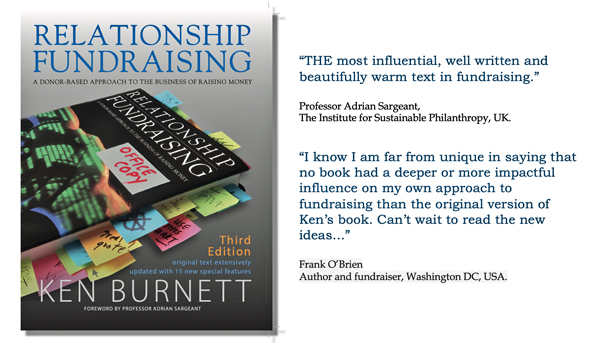|
|
‘...he has calculated the relative values of donors as they move up and down the slope and the resulting shape is not even close to triangular.’
‘The nature of our relationship with donors is changing, perhaps irrevocably, perhaps not positively...’ More blogs on fundraising and communication Tales from The Field by the River: And also a special Vist SOFII for more from Ken Burnett: |
The opening several weeks of 2010 have seen all sorts of opinions bandied about the blogosphere by the fundraising chattering classes. The focus of their concerns this time has been the merits, or otherwise, of that fine institution, our old friend the donor pyramid. The exquisite and much admired Agitator has even descended into the fray, running a series of increasingly sensationalised editorials under the scandal-mongering headline, The Donor Pyramid Lie. Politely, Tom Belford there has granted this humble columnist the last word (see The Agitator, and below), though I have no doubt that others will sneak in subsequent opinions by the back door that is their ‘comments’ option. Good, say I, as it’s an issue that never tires me. And many others, I’m sure. For in its various transformations the donor pyramid is a subject that excites hot passions, on all sides of the debate. To quote the blessed George Smith, how dare they? How dare they? To add to this, the learned John Rodd, a man who knows data in all its formats and complexities, told me recently that he has calculated the relative values of donors as they move up and down the slope (we should be grateful) and the resulting shape is not even close to triangular. Which, I think, proves the point that our illustrious pyramid is nothing more than what it always has been: a convenient way of illustrating the direction we’d like to imagine most of our donor relationships will follow – with or without our interference. Who are we to cry, ‘Outrage!’, if they then decide to do things differently? Fortunately for fundraisers the magic of averages dictates that most won’t. So these formulaic shapes, while not infallible, are still valid and valuable. Eighteen years ago when describing the evolutions, or mutations, illustrated opposite I was merely trying to broaden the debate, partly to help fundraisers of course, but mainly I confess because I find fundraisers reactions to and expectations from the pyramid so enjoyable. I’m sure future fundraisers will continue to evolve improved versions too. (I’d originally thought to predict some of these in this article and was going to title the piece Things of Shapes to Come, but decided against it.)
I love the donor pyramid, but it’s not a panacea. What is most significant and serious for our profession now is that the nature of our relationship with donors is certainly changing, perhaps irrevocably, perhaps not positively. Alas, whatever we do or don’t do about this, it probably won’t be anything triangular, or any other shape for that matter, that will point us in the right direction to anticipate or even interpret our donors’ changing needs. Even if we could conceive the donor dodecahedron (above) it was always unlikely that a single geometric construct would solve all our problems. So while there’s much merit in the continuing efforts of Tony Elischer (Agitator 26/01/10) and others to redefine and enhance the pyramid, whatever we do to it won’t help us to provide our donors with a more fulfilling experience or to get half decent at things like giving brilliant feedback and saying thank you and welcome properly. These are the things we really need to refine and improve if we want to increase engagement and income from donors. Nevertheless, it would be premature to lament the faithful old pyramid’s passing, for it still has its uses, if only for fundraisers who know precisely what they should do with it. Anyway, you’ll see, opposite, the ‘last word’ that the people at The Agitator allowed me. I should point out though that I was, obviously, attempting to be ironic in this observation. As everyone well knows, Og the Benevolent was dispensing his wisdom in 563 AD, not BC. © Ken Burnett 2010 Ken Burnett’s books on fundraising and communication include the classic Relationship Fundraising: a donor-based approach to the business of raising money, Friends for Life: relationship fundraising in practice and The Zen of Fundraising. For books that should grace your bookshelf, click here.
|
From The Agitator, 29 January 2010
Of course, the fundamental issue we have been exploring here is how to win increasing support from every donor. With that goal in mind, Roger will attempt to draw some insights out of this week’s discussion and offer some direction (and resources) in his upcoming posts. (Follow that here.) Tom
|

 Og the Benevolent (486-569 AD).
Og the Benevolent (486-569 AD). Mrs Og, the even more charitable
Mrs Og, the even more charitable

 Way back in 1992 the donor pyramid and its rivals were hotly debated whenever and wherever fundraisers congregated. But is it still relevant, today? The page above is from the first edition of Burnett’s
Way back in 1992 the donor pyramid and its rivals were hotly debated whenever and wherever fundraisers congregated. But is it still relevant, today? The page above is from the first edition of Burnett’s 